Obama's Leadership Skills Profile Analysis 2022
VerifiedAdded on 2022/09/26
|9
|2668
|22
AI Summary
refer the below attachment.
Contribute Materials
Your contribution can guide someone’s learning journey. Share your
documents today.

Surname 1
Name
Instructor
Institution
Course
Date
Executive summary
Leadership styles refer to the school of thoughts used to explain why and the method
some persons use to become leaders. Leadership theories are many and can be applied in various
circumstances. Each of the leadership style is unique from the other and has various aspects.
Leadership styles assist leaders in achieving their dreams and make management easy. This
paper will discuss the leadership traits portrayed by President Barrack Obama.
Name
Instructor
Institution
Course
Date
Executive summary
Leadership styles refer to the school of thoughts used to explain why and the method
some persons use to become leaders. Leadership theories are many and can be applied in various
circumstances. Each of the leadership style is unique from the other and has various aspects.
Leadership styles assist leaders in achieving their dreams and make management easy. This
paper will discuss the leadership traits portrayed by President Barrack Obama.
Secure Best Marks with AI Grader
Need help grading? Try our AI Grader for instant feedback on your assignments.
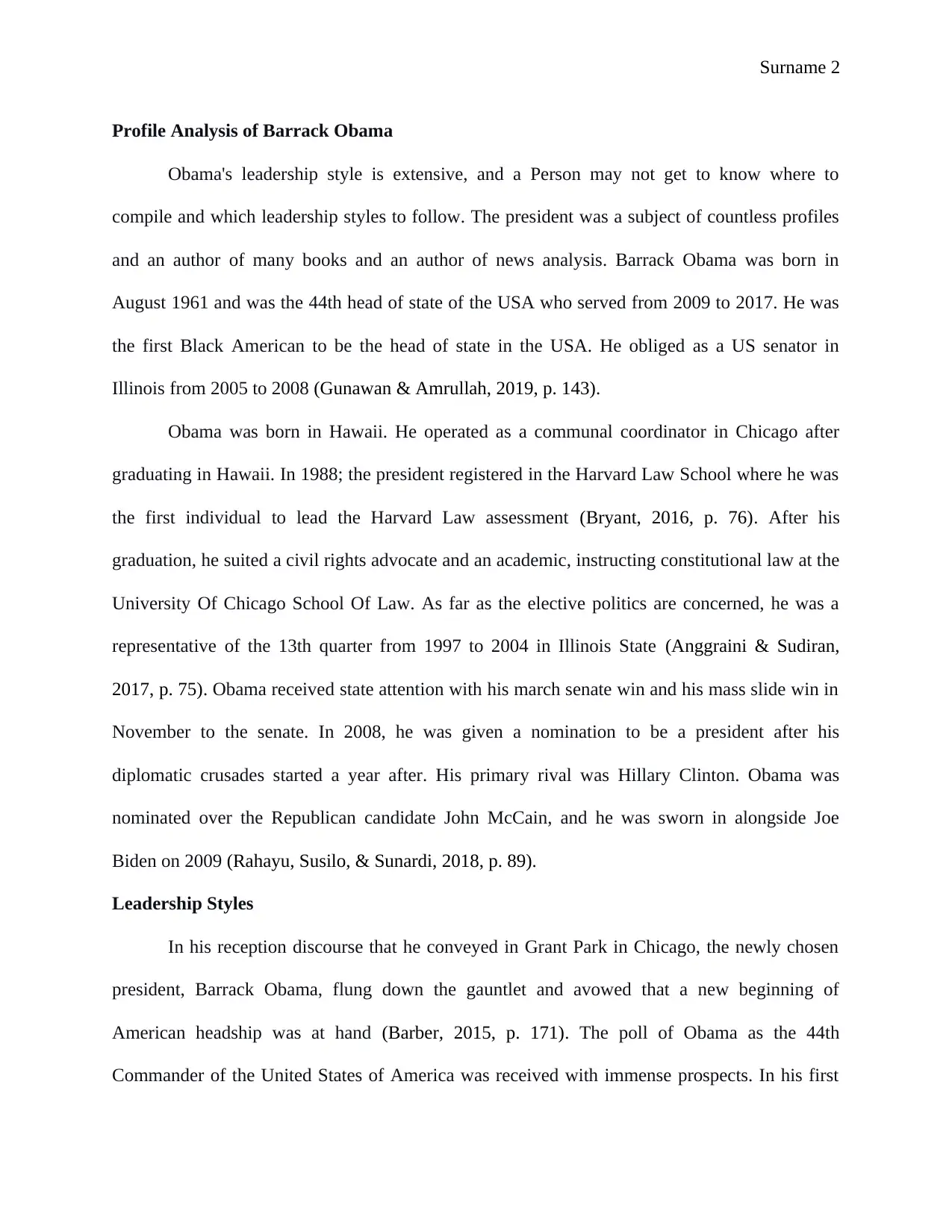
Surname 2
Profile Analysis of Barrack Obama
Obama's leadership style is extensive, and a Person may not get to know where to
compile and which leadership styles to follow. The president was a subject of countless profiles
and an author of many books and an author of news analysis. Barrack Obama was born in
August 1961 and was the 44th head of state of the USA who served from 2009 to 2017. He was
the first Black American to be the head of state in the USA. He obliged as a US senator in
Illinois from 2005 to 2008 (Gunawan & Amrullah, 2019, p. 143).
Obama was born in Hawaii. He operated as a communal coordinator in Chicago after
graduating in Hawaii. In 1988; the president registered in the Harvard Law School where he was
the first individual to lead the Harvard Law assessment (Bryant, 2016, p. 76). After his
graduation, he suited a civil rights advocate and an academic, instructing constitutional law at the
University Of Chicago School Of Law. As far as the elective politics are concerned, he was a
representative of the 13th quarter from 1997 to 2004 in Illinois State (Anggraini & Sudiran,
2017, p. 75). Obama received state attention with his march senate win and his mass slide win in
November to the senate. In 2008, he was given a nomination to be a president after his
diplomatic crusades started a year after. His primary rival was Hillary Clinton. Obama was
nominated over the Republican candidate John McCain, and he was sworn in alongside Joe
Biden on 2009 (Rahayu, Susilo, & Sunardi, 2018, p. 89).
Leadership Styles
In his reception discourse that he conveyed in Grant Park in Chicago, the newly chosen
president, Barrack Obama, flung down the gauntlet and avowed that a new beginning of
American headship was at hand (Barber, 2015, p. 171). The poll of Obama as the 44th
Commander of the United States of America was received with immense prospects. In his first
Profile Analysis of Barrack Obama
Obama's leadership style is extensive, and a Person may not get to know where to
compile and which leadership styles to follow. The president was a subject of countless profiles
and an author of many books and an author of news analysis. Barrack Obama was born in
August 1961 and was the 44th head of state of the USA who served from 2009 to 2017. He was
the first Black American to be the head of state in the USA. He obliged as a US senator in
Illinois from 2005 to 2008 (Gunawan & Amrullah, 2019, p. 143).
Obama was born in Hawaii. He operated as a communal coordinator in Chicago after
graduating in Hawaii. In 1988; the president registered in the Harvard Law School where he was
the first individual to lead the Harvard Law assessment (Bryant, 2016, p. 76). After his
graduation, he suited a civil rights advocate and an academic, instructing constitutional law at the
University Of Chicago School Of Law. As far as the elective politics are concerned, he was a
representative of the 13th quarter from 1997 to 2004 in Illinois State (Anggraini & Sudiran,
2017, p. 75). Obama received state attention with his march senate win and his mass slide win in
November to the senate. In 2008, he was given a nomination to be a president after his
diplomatic crusades started a year after. His primary rival was Hillary Clinton. Obama was
nominated over the Republican candidate John McCain, and he was sworn in alongside Joe
Biden on 2009 (Rahayu, Susilo, & Sunardi, 2018, p. 89).
Leadership Styles
In his reception discourse that he conveyed in Grant Park in Chicago, the newly chosen
president, Barrack Obama, flung down the gauntlet and avowed that a new beginning of
American headship was at hand (Barber, 2015, p. 171). The poll of Obama as the 44th
Commander of the United States of America was received with immense prospects. In his first
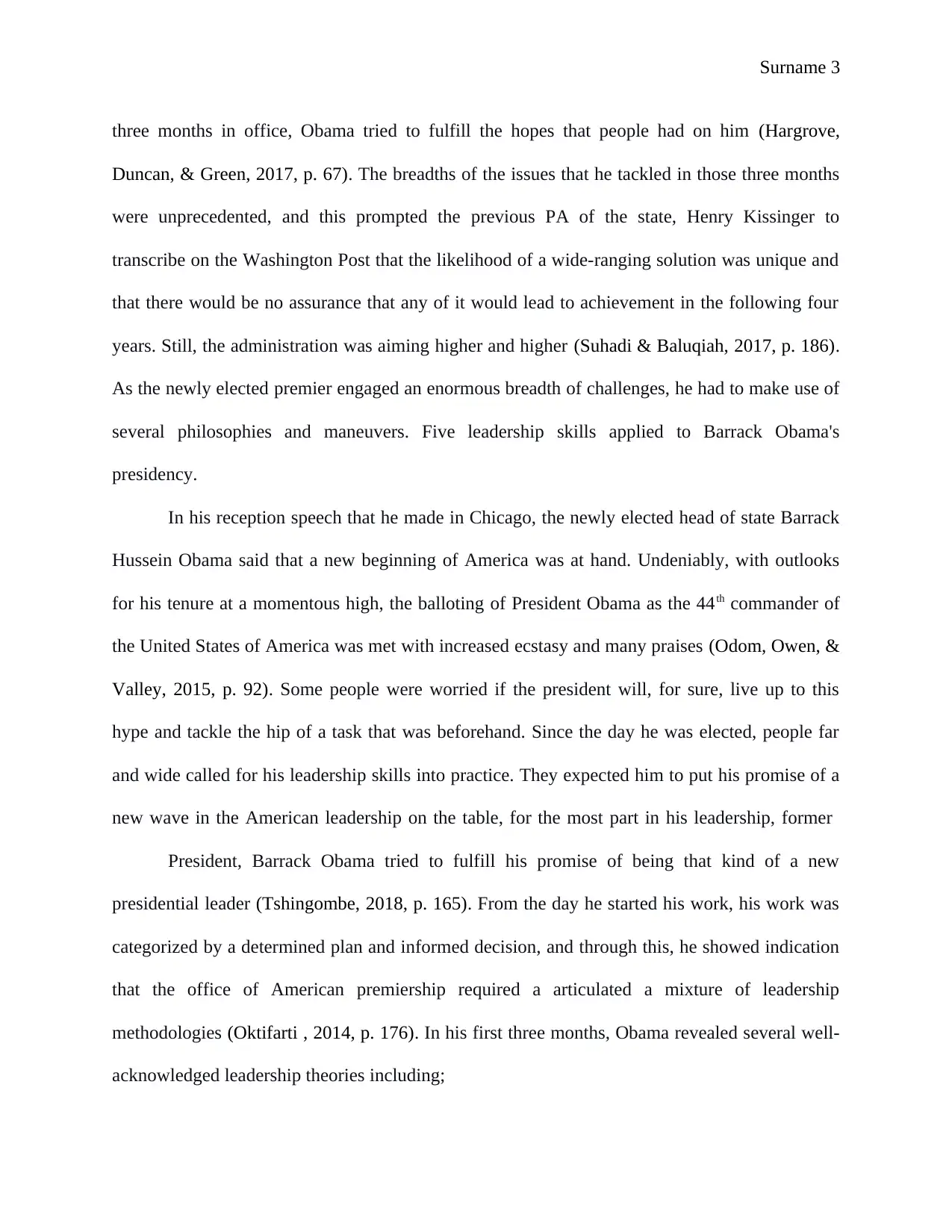
Surname 3
three months in office, Obama tried to fulfill the hopes that people had on him (Hargrove,
Duncan, & Green, 2017, p. 67). The breadths of the issues that he tackled in those three months
were unprecedented, and this prompted the previous PA of the state, Henry Kissinger to
transcribe on the Washington Post that the likelihood of a wide-ranging solution was unique and
that there would be no assurance that any of it would lead to achievement in the following four
years. Still, the administration was aiming higher and higher (Suhadi & Baluqiah, 2017, p. 186).
As the newly elected premier engaged an enormous breadth of challenges, he had to make use of
several philosophies and maneuvers. Five leadership skills applied to Barrack Obama's
presidency.
In his reception speech that he made in Chicago, the newly elected head of state Barrack
Hussein Obama said that a new beginning of America was at hand. Undeniably, with outlooks
for his tenure at a momentous high, the balloting of President Obama as the 44th commander of
the United States of America was met with increased ecstasy and many praises (Odom, Owen, &
Valley, 2015, p. 92). Some people were worried if the president will, for sure, live up to this
hype and tackle the hip of a task that was beforehand. Since the day he was elected, people far
and wide called for his leadership skills into practice. They expected him to put his promise of a
new wave in the American leadership on the table, for the most part in his leadership, former
President, Barrack Obama tried to fulfill his promise of being that kind of a new
presidential leader (Tshingombe, 2018, p. 165). From the day he started his work, his work was
categorized by a determined plan and informed decision, and through this, he showed indication
that the office of American premiership required a articulated a mixture of leadership
methodologies (Oktifarti , 2014, p. 176). In his first three months, Obama revealed several well-
acknowledged leadership theories including;
three months in office, Obama tried to fulfill the hopes that people had on him (Hargrove,
Duncan, & Green, 2017, p. 67). The breadths of the issues that he tackled in those three months
were unprecedented, and this prompted the previous PA of the state, Henry Kissinger to
transcribe on the Washington Post that the likelihood of a wide-ranging solution was unique and
that there would be no assurance that any of it would lead to achievement in the following four
years. Still, the administration was aiming higher and higher (Suhadi & Baluqiah, 2017, p. 186).
As the newly elected premier engaged an enormous breadth of challenges, he had to make use of
several philosophies and maneuvers. Five leadership skills applied to Barrack Obama's
presidency.
In his reception speech that he made in Chicago, the newly elected head of state Barrack
Hussein Obama said that a new beginning of America was at hand. Undeniably, with outlooks
for his tenure at a momentous high, the balloting of President Obama as the 44th commander of
the United States of America was met with increased ecstasy and many praises (Odom, Owen, &
Valley, 2015, p. 92). Some people were worried if the president will, for sure, live up to this
hype and tackle the hip of a task that was beforehand. Since the day he was elected, people far
and wide called for his leadership skills into practice. They expected him to put his promise of a
new wave in the American leadership on the table, for the most part in his leadership, former
President, Barrack Obama tried to fulfill his promise of being that kind of a new
presidential leader (Tshingombe, 2018, p. 165). From the day he started his work, his work was
categorized by a determined plan and informed decision, and through this, he showed indication
that the office of American premiership required a articulated a mixture of leadership
methodologies (Oktifarti , 2014, p. 176). In his first three months, Obama revealed several well-
acknowledged leadership theories including;

Surname 4
Transformational leadership
This leadership theory demonstrated everything from the personal composure of the
president to the mastered utilization of the bully pulpit. He worked with teams to identify the
change that was needed in America and through this, he created a vision to guide change via
inspiration in his slogan 'Yes we can'. He also executed a shift in tandem. He served to enhance
motivation, morale and excellent performance in jobs through various mechanisms, including the
followers' sense of identity. He was a role model for his followers to inspire them and to raise the
interests of his promises and challenged those who served under him to take ownership of the
projects and he tried to understand the weaknesses and strengths of his followers (Szilágyi,
Mark, & Thompson, 2016, p. 165). The president used to inspire motivation when he challenged
his followers to achieve their ambitions.
Obama also made cultural amendments and progressions that surrounded his features of
ideologies. The president had an attractive personality, concepts and instincts. He brought to an
end, the 1990s reign of restrains and created a new policy that permitted gays and lesbians to
work on military openly. He reserved President Bush torture policies which were thought of as
being cold-hearted according to the Geneva resolutions (Al-Asfour & Lettau, 2014, p. 143).
Throughout his tenure, the president had an idealized influence when the leader acted as a
role model for the country and lead as an example. Barrack Obama used to consider the needs of
his political followers and prioritize their needs. He induced a positive change to his followers'
attitudes and the organization. The president performed his duties include motivation, idealized
influence, intellectual stimulation and individualized consideration (Arnold, Connelly, & Walsh,
2015, p. 355).
Transformational leadership
This leadership theory demonstrated everything from the personal composure of the
president to the mastered utilization of the bully pulpit. He worked with teams to identify the
change that was needed in America and through this, he created a vision to guide change via
inspiration in his slogan 'Yes we can'. He also executed a shift in tandem. He served to enhance
motivation, morale and excellent performance in jobs through various mechanisms, including the
followers' sense of identity. He was a role model for his followers to inspire them and to raise the
interests of his promises and challenged those who served under him to take ownership of the
projects and he tried to understand the weaknesses and strengths of his followers (Szilágyi,
Mark, & Thompson, 2016, p. 165). The president used to inspire motivation when he challenged
his followers to achieve their ambitions.
Obama also made cultural amendments and progressions that surrounded his features of
ideologies. The president had an attractive personality, concepts and instincts. He brought to an
end, the 1990s reign of restrains and created a new policy that permitted gays and lesbians to
work on military openly. He reserved President Bush torture policies which were thought of as
being cold-hearted according to the Geneva resolutions (Al-Asfour & Lettau, 2014, p. 143).
Throughout his tenure, the president had an idealized influence when the leader acted as a
role model for the country and lead as an example. Barrack Obama used to consider the needs of
his political followers and prioritize their needs. He induced a positive change to his followers'
attitudes and the organization. The president performed his duties include motivation, idealized
influence, intellectual stimulation and individualized consideration (Arnold, Connelly, & Walsh,
2015, p. 355).
Secure Best Marks with AI Grader
Need help grading? Try our AI Grader for instant feedback on your assignments.
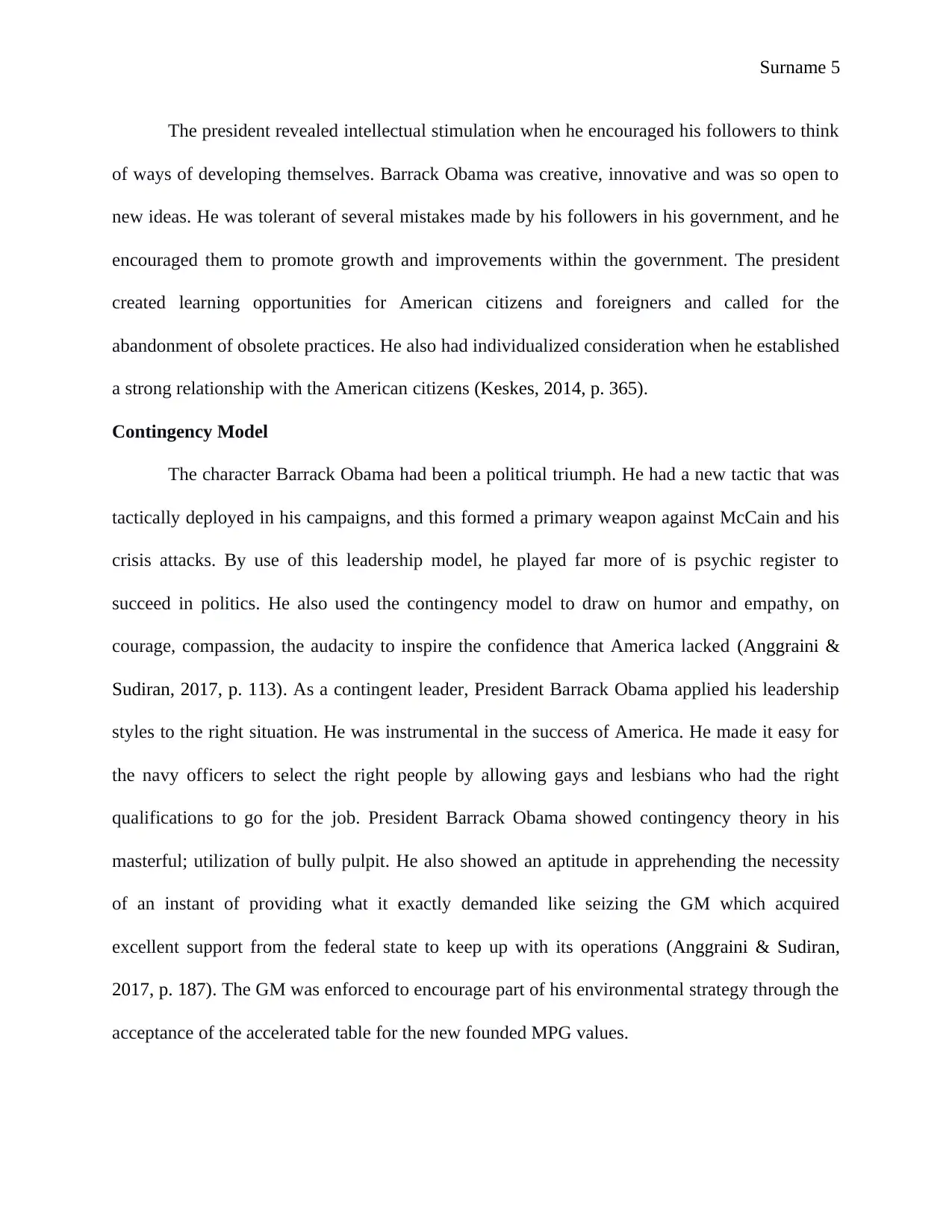
Surname 5
The president revealed intellectual stimulation when he encouraged his followers to think
of ways of developing themselves. Barrack Obama was creative, innovative and was so open to
new ideas. He was tolerant of several mistakes made by his followers in his government, and he
encouraged them to promote growth and improvements within the government. The president
created learning opportunities for American citizens and foreigners and called for the
abandonment of obsolete practices. He also had individualized consideration when he established
a strong relationship with the American citizens (Keskes, 2014, p. 365).
Contingency Model
The character Barrack Obama had been a political triumph. He had a new tactic that was
tactically deployed in his campaigns, and this formed a primary weapon against McCain and his
crisis attacks. By use of this leadership model, he played far more of is psychic register to
succeed in politics. He also used the contingency model to draw on humor and empathy, on
courage, compassion, the audacity to inspire the confidence that America lacked (Anggraini &
Sudiran, 2017, p. 113). As a contingent leader, President Barrack Obama applied his leadership
styles to the right situation. He was instrumental in the success of America. He made it easy for
the navy officers to select the right people by allowing gays and lesbians who had the right
qualifications to go for the job. President Barrack Obama showed contingency theory in his
masterful; utilization of bully pulpit. He also showed an aptitude in apprehending the necessity
of an instant of providing what it exactly demanded like seizing the GM which acquired
excellent support from the federal state to keep up with its operations (Anggraini & Sudiran,
2017, p. 187). The GM was enforced to encourage part of his environmental strategy through the
acceptance of the accelerated table for the new founded MPG values.
The president revealed intellectual stimulation when he encouraged his followers to think
of ways of developing themselves. Barrack Obama was creative, innovative and was so open to
new ideas. He was tolerant of several mistakes made by his followers in his government, and he
encouraged them to promote growth and improvements within the government. The president
created learning opportunities for American citizens and foreigners and called for the
abandonment of obsolete practices. He also had individualized consideration when he established
a strong relationship with the American citizens (Keskes, 2014, p. 365).
Contingency Model
The character Barrack Obama had been a political triumph. He had a new tactic that was
tactically deployed in his campaigns, and this formed a primary weapon against McCain and his
crisis attacks. By use of this leadership model, he played far more of is psychic register to
succeed in politics. He also used the contingency model to draw on humor and empathy, on
courage, compassion, the audacity to inspire the confidence that America lacked (Anggraini &
Sudiran, 2017, p. 113). As a contingent leader, President Barrack Obama applied his leadership
styles to the right situation. He was instrumental in the success of America. He made it easy for
the navy officers to select the right people by allowing gays and lesbians who had the right
qualifications to go for the job. President Barrack Obama showed contingency theory in his
masterful; utilization of bully pulpit. He also showed an aptitude in apprehending the necessity
of an instant of providing what it exactly demanded like seizing the GM which acquired
excellent support from the federal state to keep up with its operations (Anggraini & Sudiran,
2017, p. 187). The GM was enforced to encourage part of his environmental strategy through the
acceptance of the accelerated table for the new founded MPG values.
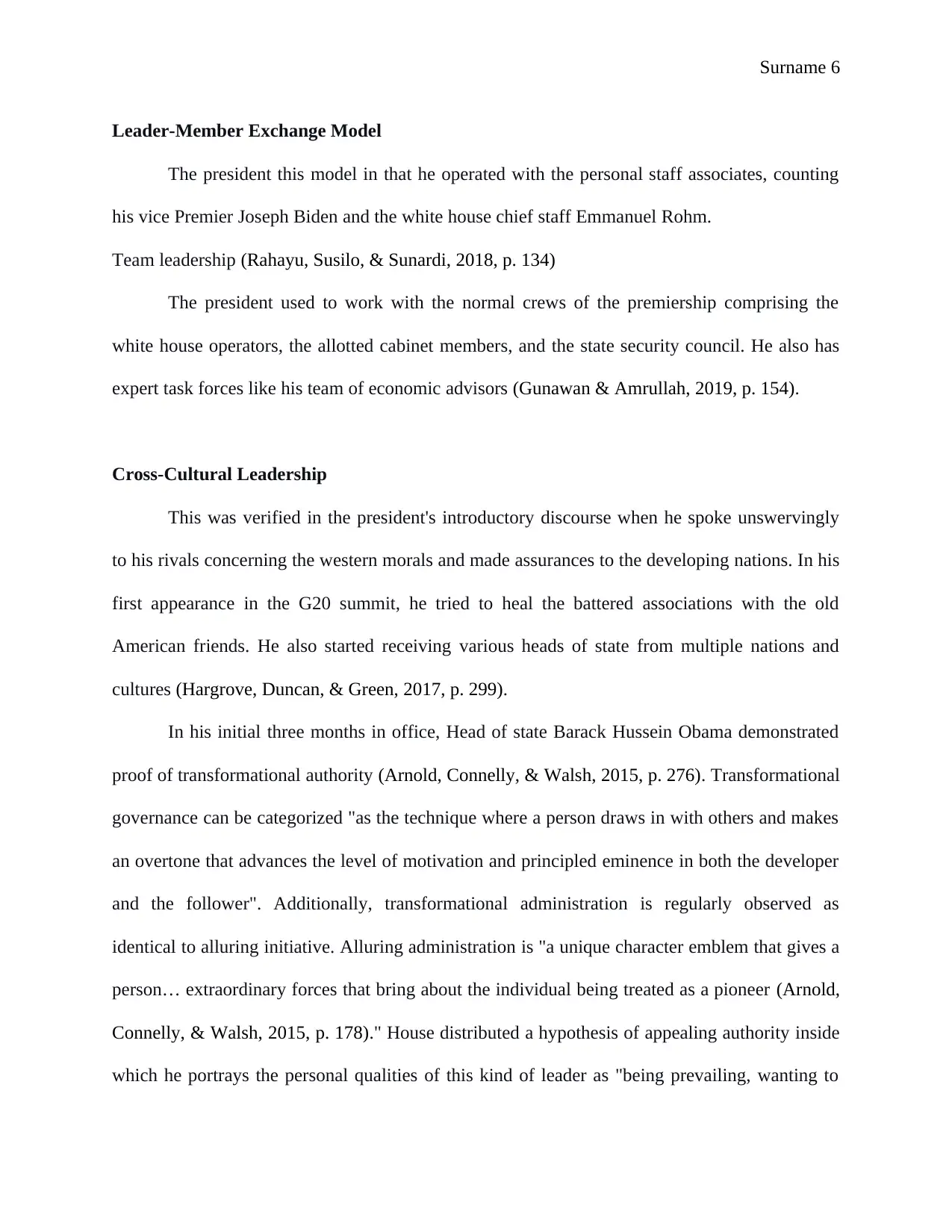
Surname 6
Leader-Member Exchange Model
The president this model in that he operated with the personal staff associates, counting
his vice Premier Joseph Biden and the white house chief staff Emmanuel Rohm.
Team leadership (Rahayu, Susilo, & Sunardi, 2018, p. 134)
The president used to work with the normal crews of the premiership comprising the
white house operators, the allotted cabinet members, and the state security council. He also has
expert task forces like his team of economic advisors (Gunawan & Amrullah, 2019, p. 154).
Cross-Cultural Leadership
This was verified in the president's introductory discourse when he spoke unswervingly
to his rivals concerning the western morals and made assurances to the developing nations. In his
first appearance in the G20 summit, he tried to heal the battered associations with the old
American friends. He also started receiving various heads of state from multiple nations and
cultures (Hargrove, Duncan, & Green, 2017, p. 299).
In his initial three months in office, Head of state Barack Hussein Obama demonstrated
proof of transformational authority (Arnold, Connelly, & Walsh, 2015, p. 276). Transformational
governance can be categorized "as the technique where a person draws in with others and makes
an overtone that advances the level of motivation and principled eminence in both the developer
and the follower". Additionally, transformational administration is regularly observed as
identical to alluring initiative. Alluring administration is "a unique character emblem that gives a
person… extraordinary forces that bring about the individual being treated as a pioneer (Arnold,
Connelly, & Walsh, 2015, p. 178)." House distributed a hypothesis of appealing authority inside
which he portrays the personal qualities of this kind of leader as "being prevailing, wanting to
Leader-Member Exchange Model
The president this model in that he operated with the personal staff associates, counting
his vice Premier Joseph Biden and the white house chief staff Emmanuel Rohm.
Team leadership (Rahayu, Susilo, & Sunardi, 2018, p. 134)
The president used to work with the normal crews of the premiership comprising the
white house operators, the allotted cabinet members, and the state security council. He also has
expert task forces like his team of economic advisors (Gunawan & Amrullah, 2019, p. 154).
Cross-Cultural Leadership
This was verified in the president's introductory discourse when he spoke unswervingly
to his rivals concerning the western morals and made assurances to the developing nations. In his
first appearance in the G20 summit, he tried to heal the battered associations with the old
American friends. He also started receiving various heads of state from multiple nations and
cultures (Hargrove, Duncan, & Green, 2017, p. 299).
In his initial three months in office, Head of state Barack Hussein Obama demonstrated
proof of transformational authority (Arnold, Connelly, & Walsh, 2015, p. 276). Transformational
governance can be categorized "as the technique where a person draws in with others and makes
an overtone that advances the level of motivation and principled eminence in both the developer
and the follower". Additionally, transformational administration is regularly observed as
identical to alluring initiative. Alluring administration is "a unique character emblem that gives a
person… extraordinary forces that bring about the individual being treated as a pioneer (Arnold,
Connelly, & Walsh, 2015, p. 178)." House distributed a hypothesis of appealing authority inside
which he portrays the personal qualities of this kind of leader as "being prevailing, wanting to
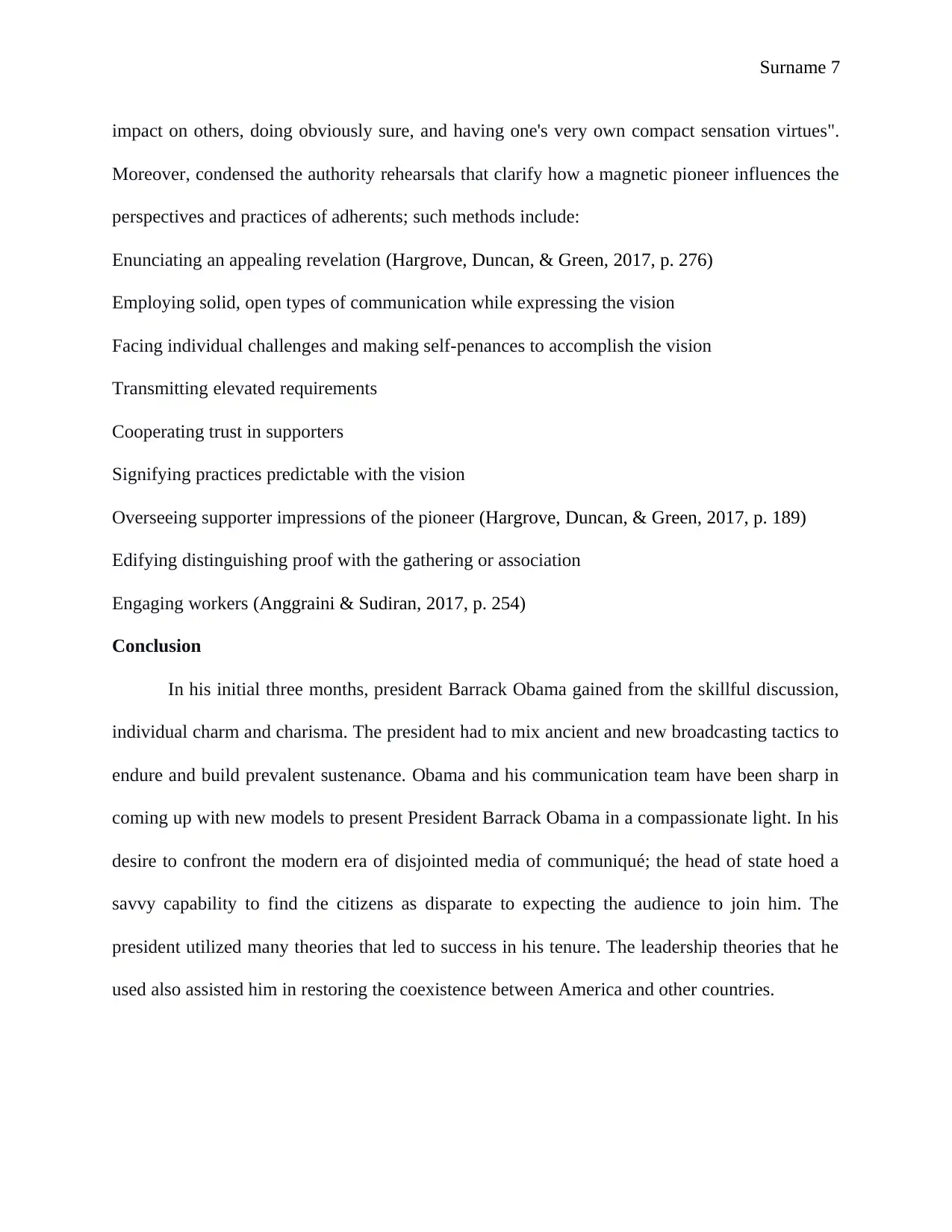
Surname 7
impact on others, doing obviously sure, and having one's very own compact sensation virtues".
Moreover, condensed the authority rehearsals that clarify how a magnetic pioneer influences the
perspectives and practices of adherents; such methods include:
Enunciating an appealing revelation (Hargrove, Duncan, & Green, 2017, p. 276)
Employing solid, open types of communication while expressing the vision
Facing individual challenges and making self-penances to accomplish the vision
Transmitting elevated requirements
Cooperating trust in supporters
Signifying practices predictable with the vision
Overseeing supporter impressions of the pioneer (Hargrove, Duncan, & Green, 2017, p. 189)
Edifying distinguishing proof with the gathering or association
Engaging workers (Anggraini & Sudiran, 2017, p. 254)
Conclusion
In his initial three months, president Barrack Obama gained from the skillful discussion,
individual charm and charisma. The president had to mix ancient and new broadcasting tactics to
endure and build prevalent sustenance. Obama and his communication team have been sharp in
coming up with new models to present President Barrack Obama in a compassionate light. In his
desire to confront the modern era of disjointed media of communiqué; the head of state hoed a
savvy capability to find the citizens as disparate to expecting the audience to join him. The
president utilized many theories that led to success in his tenure. The leadership theories that he
used also assisted him in restoring the coexistence between America and other countries.
impact on others, doing obviously sure, and having one's very own compact sensation virtues".
Moreover, condensed the authority rehearsals that clarify how a magnetic pioneer influences the
perspectives and practices of adherents; such methods include:
Enunciating an appealing revelation (Hargrove, Duncan, & Green, 2017, p. 276)
Employing solid, open types of communication while expressing the vision
Facing individual challenges and making self-penances to accomplish the vision
Transmitting elevated requirements
Cooperating trust in supporters
Signifying practices predictable with the vision
Overseeing supporter impressions of the pioneer (Hargrove, Duncan, & Green, 2017, p. 189)
Edifying distinguishing proof with the gathering or association
Engaging workers (Anggraini & Sudiran, 2017, p. 254)
Conclusion
In his initial three months, president Barrack Obama gained from the skillful discussion,
individual charm and charisma. The president had to mix ancient and new broadcasting tactics to
endure and build prevalent sustenance. Obama and his communication team have been sharp in
coming up with new models to present President Barrack Obama in a compassionate light. In his
desire to confront the modern era of disjointed media of communiqué; the head of state hoed a
savvy capability to find the citizens as disparate to expecting the audience to join him. The
president utilized many theories that led to success in his tenure. The leadership theories that he
used also assisted him in restoring the coexistence between America and other countries.
Paraphrase This Document
Need a fresh take? Get an instant paraphrase of this document with our AI Paraphraser
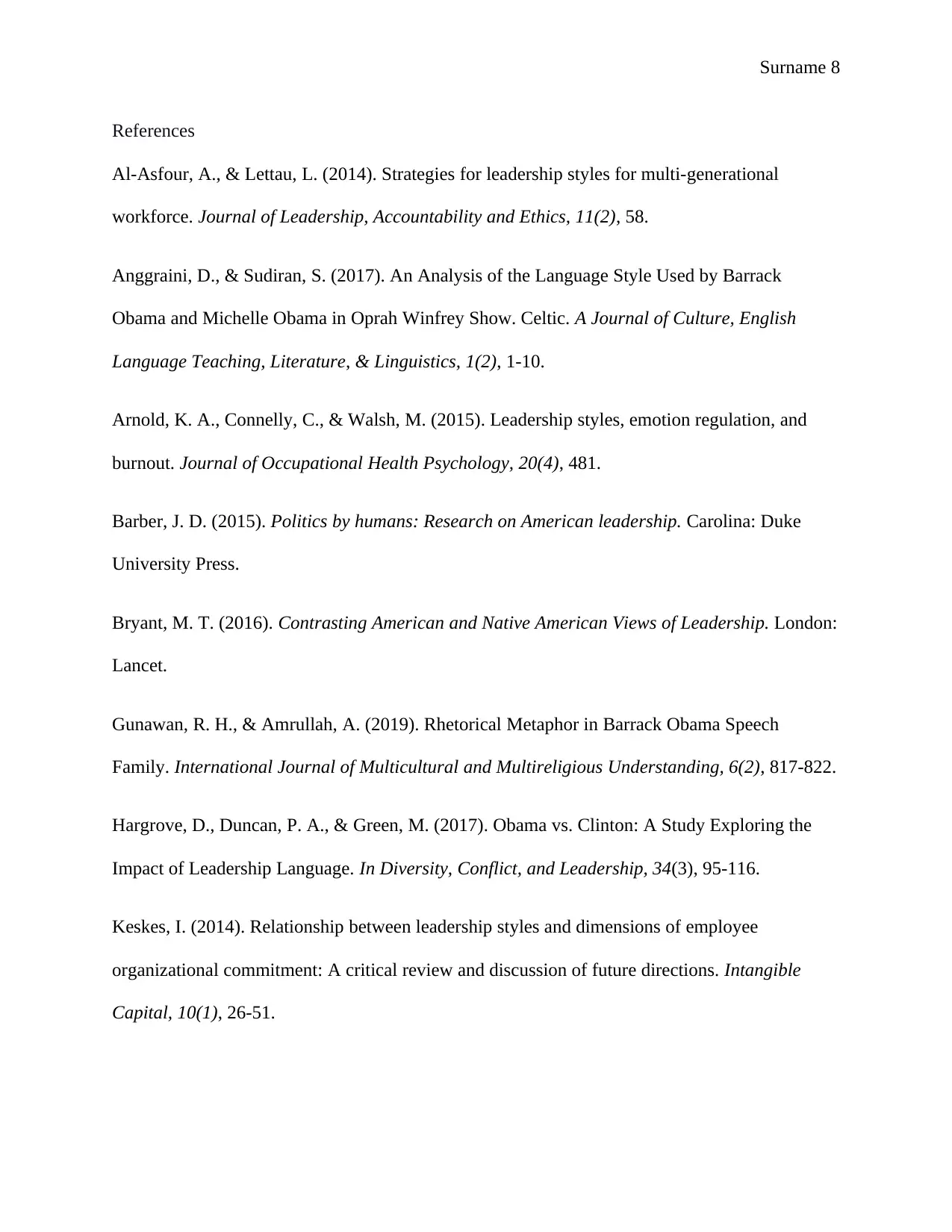
Surname 8
References
Al-Asfour, A., & Lettau, L. (2014). Strategies for leadership styles for multi-generational
workforce. Journal of Leadership, Accountability and Ethics, 11(2), 58.
Anggraini, D., & Sudiran, S. (2017). An Analysis of the Language Style Used by Barrack
Obama and Michelle Obama in Oprah Winfrey Show. Celtic. A Journal of Culture, English
Language Teaching, Literature, & Linguistics, 1(2), 1-10.
Arnold, K. A., Connelly, C., & Walsh, M. (2015). Leadership styles, emotion regulation, and
burnout. Journal of Occupational Health Psychology, 20(4), 481.
Barber, J. D. (2015). Politics by humans: Research on American leadership. Carolina: Duke
University Press.
Bryant, M. T. (2016). Contrasting American and Native American Views of Leadership. London:
Lancet.
Gunawan, R. H., & Amrullah, A. (2019). Rhetorical Metaphor in Barrack Obama Speech
Family. International Journal of Multicultural and Multireligious Understanding, 6(2), 817-822.
Hargrove, D., Duncan, P. A., & Green, M. (2017). Obama vs. Clinton: A Study Exploring the
Impact of Leadership Language. In Diversity, Conflict, and Leadership, 34(3), 95-116.
Keskes, I. (2014). Relationship between leadership styles and dimensions of employee
organizational commitment: A critical review and discussion of future directions. Intangible
Capital, 10(1), 26-51.
References
Al-Asfour, A., & Lettau, L. (2014). Strategies for leadership styles for multi-generational
workforce. Journal of Leadership, Accountability and Ethics, 11(2), 58.
Anggraini, D., & Sudiran, S. (2017). An Analysis of the Language Style Used by Barrack
Obama and Michelle Obama in Oprah Winfrey Show. Celtic. A Journal of Culture, English
Language Teaching, Literature, & Linguistics, 1(2), 1-10.
Arnold, K. A., Connelly, C., & Walsh, M. (2015). Leadership styles, emotion regulation, and
burnout. Journal of Occupational Health Psychology, 20(4), 481.
Barber, J. D. (2015). Politics by humans: Research on American leadership. Carolina: Duke
University Press.
Bryant, M. T. (2016). Contrasting American and Native American Views of Leadership. London:
Lancet.
Gunawan, R. H., & Amrullah, A. (2019). Rhetorical Metaphor in Barrack Obama Speech
Family. International Journal of Multicultural and Multireligious Understanding, 6(2), 817-822.
Hargrove, D., Duncan, P. A., & Green, M. (2017). Obama vs. Clinton: A Study Exploring the
Impact of Leadership Language. In Diversity, Conflict, and Leadership, 34(3), 95-116.
Keskes, I. (2014). Relationship between leadership styles and dimensions of employee
organizational commitment: A critical review and discussion of future directions. Intangible
Capital, 10(1), 26-51.

Surname 9
Odom, L., Owen, R., & Valley, A. (2015). Obamacare: an ethical analysis of his leadership and
the health reform initiative. New Perspectives in Healthcare: Impacts of Regulation,
Organization, Reform and Change in the United States Health System, 45(5), 37-45.
Oktifarti , L. (2014). Transitivity and Ideology: A Critical Discourse Analysis of Obama’s
Second Inaugural Speech. Language Horizon, 20(4), 20-44.
Rahayu, F., Susilo, S., & Sunardi, S. (2018). PERSUASIVE POWER AS REFLECTED BY
RHETORICAL STYLES IN POLITICAL SPEECHES: A COMPARATIVE STUDY OF
BARRACK OBAMA AND JOHN MCCAIN. CaLLs. Journal of Culture, Arts, Literature, and
Linguistics, 4(2), 115-122.
Suhadi, A., & Baluqiah, K. (2017). DONALD TRUMP AND BARRACK OBAMA’S
INAUGURAL ADDRESS: STYLISTIC ANALYSIS. Proceedings of ISELT FBS Universitas
Negeri Padang, 5(3), 169-177.
Szilágyi, A., Mark, R., & Thompson, T. (2016). Digong and the Donald. The Indiscreet Charm
of Informality in Politics, 46(12), 254-276.
Tshingombe, T. C. (2018). Leadership styles commonly applied by managers to motivate
subordinates to perform. Journal of survey of managers' perception, 57(6), 243-265.
Odom, L., Owen, R., & Valley, A. (2015). Obamacare: an ethical analysis of his leadership and
the health reform initiative. New Perspectives in Healthcare: Impacts of Regulation,
Organization, Reform and Change in the United States Health System, 45(5), 37-45.
Oktifarti , L. (2014). Transitivity and Ideology: A Critical Discourse Analysis of Obama’s
Second Inaugural Speech. Language Horizon, 20(4), 20-44.
Rahayu, F., Susilo, S., & Sunardi, S. (2018). PERSUASIVE POWER AS REFLECTED BY
RHETORICAL STYLES IN POLITICAL SPEECHES: A COMPARATIVE STUDY OF
BARRACK OBAMA AND JOHN MCCAIN. CaLLs. Journal of Culture, Arts, Literature, and
Linguistics, 4(2), 115-122.
Suhadi, A., & Baluqiah, K. (2017). DONALD TRUMP AND BARRACK OBAMA’S
INAUGURAL ADDRESS: STYLISTIC ANALYSIS. Proceedings of ISELT FBS Universitas
Negeri Padang, 5(3), 169-177.
Szilágyi, A., Mark, R., & Thompson, T. (2016). Digong and the Donald. The Indiscreet Charm
of Informality in Politics, 46(12), 254-276.
Tshingombe, T. C. (2018). Leadership styles commonly applied by managers to motivate
subordinates to perform. Journal of survey of managers' perception, 57(6), 243-265.
1 out of 9
Related Documents
Your All-in-One AI-Powered Toolkit for Academic Success.
+13062052269
info@desklib.com
Available 24*7 on WhatsApp / Email
![[object Object]](/_next/static/media/star-bottom.7253800d.svg)
Unlock your academic potential
© 2024 | Zucol Services PVT LTD | All rights reserved.




